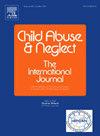Algorithmic tools to help social workers in child protection service make well-informed decisions: A scoping review
IF 3.4
2区 心理学
Q1 FAMILY STUDIES
引用次数: 0
Abstract
Introduction
Decisions on whether to investigate a report of child maltreatment or to remove a child from home are often problematic and surrounded by many uncertainties. Several tools have been developed to improve decision-making in child protection services, but little is known about which tools are used and their advantages and disadvantages.
Aim
To provide an overview of algorithm-based decision support tools and to investigate whether these innovative tools can support social workers make better decisions.
Method
We conducted a scoping literature review (from 2000 to 2022) using seven databases. We used ASReview, an innovative program that uses machine learning and algorithms in screening large quantities of text.
Results
All 24 studies originate from North America (77 %) and Europe. Most studies (83 %) focus on tools predicting the risk of maltreatment. Some studies (17 %) focus on prescriptive tools which render advice on the best intervention strategy. Eight tools are discussed, with the ‘Alleghany Family Screening Tool’ (‘AFST’) and the ‘Child and Adolescent Needs and Strengths’ (‘CANS’) as the most frequently referenced.
Conclusion
The use of algorithmic decision-support tools in child protection services is still in its infancy. In general, considering the positive results, we believe that the CANS, the artificial neural networks tool and the boosted tree model are the most promising tools to be further tested at this stage. However, ethical concerns have been raised in almost every study, particularly concerns in respect of racial disparities. More research is required before these tools can be used on a large scale.
帮助儿童保护服务社会工作者做出明智决策的算法工具:范围审查。
关于是否调查儿童虐待报告或将儿童从家中带走的决定往往是有问题的,并被许多不确定因素所包围。为改进儿童保护服务方面的决策制定了若干工具,但对于使用了哪些工具及其优缺点知之甚少。目的:概述基于算法的决策支持工具,并调查这些创新工具是否可以帮助社会工作者做出更好的决策。方法:使用7个数据库进行范围文献综述(2000 - 2022年)。我们使用了ASReview,这是一个创新的程序,它使用机器学习和算法来筛选大量文本。结果:所有24项研究均来自北美(77%)和欧洲。大多数研究(83%)侧重于预测虐待风险的工具。一些研究(17%)侧重于提供最佳干预策略建议的规范性工具。讨论了八种工具,其中“阿勒格尼家庭筛查工具”(“AFST”)和“儿童和青少年需求和优势”(“CANS”)是最常被提及的。结论:算法决策支持工具在儿童保护服务中的应用仍处于起步阶段。总的来说,考虑到积极的结果,我们认为can,人工神经网络工具和提升树模型是最有希望在这个阶段进一步测试的工具。然而,几乎每一项研究都提出了伦理问题,特别是关于种族不平等的问题。在这些工具能够大规模使用之前,还需要进行更多的研究。
本文章由计算机程序翻译,如有差异,请以英文原文为准。
求助全文
约1分钟内获得全文
求助全文
来源期刊

Child Abuse & Neglect
Multiple-
CiteScore
7.40
自引率
10.40%
发文量
397
期刊介绍:
Official Publication of the International Society for Prevention of Child Abuse and Neglect. Child Abuse & Neglect The International Journal, provides an international, multidisciplinary forum on all aspects of child abuse and neglect, with special emphasis on prevention and treatment; the scope extends further to all those aspects of life which either favor or hinder child development. While contributions will primarily be from the fields of psychology, psychiatry, social work, medicine, nursing, law enforcement, legislature, education, and anthropology, the Journal encourages the concerned lay individual and child-oriented advocate organizations to contribute.
 求助内容:
求助内容: 应助结果提醒方式:
应助结果提醒方式:


